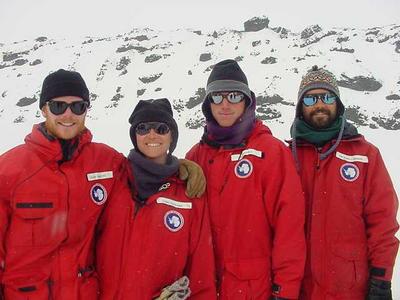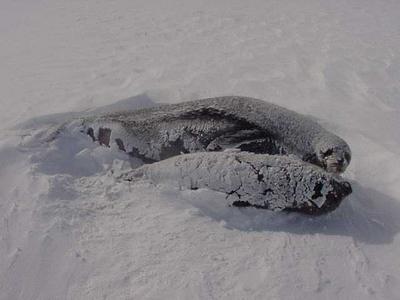
|
|
19 November, 2000
FYI answer for 11/18/00
There are about 1,000 people who live at McMurdo during the summer season. This community consumes about 20,000 pounds of food per week. In the winter season, there are only about 240 people, and they consume about 6,000 pounds per week.
Science goes on everyday here in Antarctica, even on Sundays. Mike Cameron, our team leader, Cory, Dan, and Shawn left early this morning for a one and a half-hour flight to Cape Washington. That is the location of an Emperor penguin colony. They went to tag seals that are also in that area and to assist a group of Emperor penguin researchers. The seals in this area are considered out of the study area. Katsu and I, now without Yoko, could have had a day off; however, both of us seemed to be in the lab most of the day on our computers.
After having the experience of working the south part of the study area yesterday, I wanted to share my many observations of a census day. The census takes place at regular intervals (if the weather cooperates), every third or fourth day, to count seals and verify tags. Some seals are in the water on one day but may be out the next. Some seals move from one area to another and back, and others are always found in the same area. There may be a seal or two that hadn't been seen for a long period and now they have returned.
We always work in pairs and spread out to cover the entire area. One pair starts to the south, one to the north, and one pair covers the middle. We are familiar with the island cracks and the ice cracks that run out in the open where seals have established a colony. I have worked with Katsu and Yoko doing the census for Turks Head and Big Razorback Island. I worked a larger area, the south end of the study area, with Shawn. We started at Scott Base and covered locations called Nob Pont, Trtle Rock, Hutton Cliffs and South Base. There seems to be a lot more cracks in this part of the area. With the three days of new snow it was difficult to find those cracks unless you ended up in one. That did happen all day.
Shawn and I would separate and he would go to one end and we would work towards the middle. I had a notebook and a field computer to record data. We logged the name of where we were and the latitude and longitude. I approached many of the seals very slowly and quietly because they were sleeping. In the notebook, I record the class of the seal: adult, yearling, or pup, then its sex. If the female has a pup, I would record the information on the pup also. Then I look at the tags that are on their tail flippers and record them. There are adult males and females that do not have tags. The pups without tags have to be tagged. Most of them were done in October and early November. We had one at the Turtle Rock location that Shawn tagged. We still have to record the adults that don't have tags for population count.
I found myself really using my sense of sight to look at the placement of the seals in these different areas. I found it unique how the mothers protect their pups from the wind. At some colonies, mothers with pups were spaced closer together and others seemed more spread out. I tried to see if I saw a pattern based on the way the wind always seems to blow, being more out in the open, or less open crack areas. Being in the area only once, I didn't come to a conclusion of any kind. I really enjoyed trying though.
Many of the seals were covered in a lot of snow from the past three days. I would have to use my ice ax to gently and quietly try to uncover the tag on their tail to read it and not wake them if I hadn't already. Some of the seals, male or female, just did not like an approaching human. I had to turn and back away or run from some, and others I had to play a run-around-in-circles-to-read-the-tag routine, because they kept spinning. Older tags have become aged and soetimes one could find a broken tag so it needed to be taken off and another set put on. There are always two tags with the same number attached, one to one tail flipper and another to the other tail flipper. It is easier to get a glimpse of one or the other when looking at numbers. There are also two in case one is broken or torn off in fights. The tags are different colors from different seasons and there are two to four digits. The tags from this season are four digits and yellow.
FYI
No one ___________ Antarctica. A passport is not required to ___________. It is a free, open, unmilitarized land of international _________________ and scientific

This is the Census Crew: Dan, Cory, Shawn and Mike

All census information is recorded in a notebook and a field computer

This makes reading their tags a little more challenging to read without bothering them
Contact the TEA in the field at
.
If you cannot connect through your browser, copy the
TEA's e-mail address in the "To:" line of
your favorite e-mail package.
|
